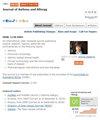Sustained Effectiveness of Benralizumab in Naïve and Biologics-Experienced Severe Eosinophilic Asthma Patients: Results from the ANANKE Study
IF 3.7
3区 医学
Q2 ALLERGY
引用次数: 0
Abstract
Purpose: Severe eosinophilic asthma (SEA) patients often present overlapping inflammatory features rendering them eligible for multiple biologic therapies; switching biologic treatment is a strategy adopted to optimize asthma control when patients show partial or no response to previous biologics.Patients and Methods: ANANKE is a retrospective, multicenter Italian study (NCT04272463). Here, we outline the characteristics and long-term clinical outcomes in naïve-to-biologics and biologics-experienced patients treated with benralizumab for up to 96 weeks. Bio-experienced patients were split into omalizumab and mepolizumab subsets according to the type of biologic previously used.
Results: A total of 124 (76.5%) naïve and 38 (23.5%) bio-experienced patients were evaluated at index date; 13 patients (34.2%) switched from mepolizumab, 21 patients (55.3%) switched from omalizumab, and four patients (10.5%) received both biologics. The mepolizumab subset was characterized by the longest SEA duration (median of 4.6 years), the highest prevalence of chronic rhinosinusitis with nasal polyposis (CRSwNP) (76.5%), and the greatest oral corticosteroid (OCS) daily dosage (median of 25 mg prednisone equivalent). The omalizumab group showed the highest severe annual exacerbation rate (AER) (1.70). At 96 weeks, treatment with benralizumab reduced any and severe AER by more than 87% and 94%, respectively, across all groups. Lung function was overall preserved, with major improvements observed in the mepolizumab group, which also revealed a 100% drop of the median OCS dose. Asthma Control Test (ACT) score improved in the naïve group while its increment was more variable in bio-experienced patients; among these, a marked difference was noticed between omalizumab and mepolizumab subsets (median ACT score of 23.5 and 18, respectively).
Conclusion: Benralizumab promotes durable and profound clinical benefits in naïve and bio-experienced groups, indicating that a nearly complete depletion of eosinophils is highly beneficial in the control of SEA, independently of previous biologic use.
Keywords: benralizumab, asthma, eosinophils, switch, long-term
本拉珠单抗对无生物制剂治疗经验和有生物制剂治疗经验的重度嗜酸性粒细胞哮喘患者的持续疗效:ANANKE研究的结果
目的:严重嗜酸性粒细胞性哮喘(SEA)患者通常具有重叠的炎症特征,因此有资格接受多种生物制剂治疗;当患者对之前的生物制剂治疗出现部分反应或无反应时,转换生物制剂治疗是优化哮喘控制的一种策略:ANANKE 是一项意大利多中心回顾性研究(NCT04272463)。在此,我们概述了接受过生物制剂治疗和有生物制剂治疗经验的患者的特征和长期临床结果。根据之前使用的生物制剂类型,有生物制剂经验的患者被分为奥马珠单抗和甲泼尼珠单抗亚组:共有124名(76.5%)新患者和38名(23.5%)有生物治疗经验的患者在指标日接受了评估;13名患者(34.2%)从美博利珠单抗转用,21名患者(55.3%)从奥马珠单抗转用,4名患者(10.5%)同时使用两种生物制剂。甲泼尼单抗亚组的特点是 SEA 持续时间最长(中位数为 4.6 年)、慢性鼻窦炎伴鼻息肉病(CRSwNP)发病率最高(76.5%)、每日口服皮质类固醇(OCS)用量最大(中位数为 25 毫克泼尼松当量)。奥马珠单抗组的严重年度恶化率(AER)最高(1.70)。在 96 周时,使用 benralizumab 治疗可使所有组的任何和严重 AER 分别减少 87% 和 94% 以上。肺功能总体上得到了保护,在mepolizumab组观察到了重大改善,该组的OCS剂量中位数也下降了100%。哮喘控制测试(ACT)评分在新药组有所改善,而在有生物经验的患者中,其增量变化较大;其中,奥马珠单抗和麦泊珠单抗亚组之间存在明显差异(ACT评分中位数分别为23.5分和18分):结论:苯拉珠单抗在新药组和有生物治疗经验组中促进了持久而深远的临床疗效,表明嗜酸性粒细胞的近乎完全耗竭对控制哮喘非常有益,与之前使用的生物制剂无关。
本文章由计算机程序翻译,如有差异,请以英文原文为准。
求助全文
约1分钟内获得全文
求助全文
来源期刊

Journal of Asthma and Allergy
Medicine-Immunology and Allergy
CiteScore
5.30
自引率
6.20%
发文量
185
审稿时长
16 weeks
期刊介绍:
An international, peer-reviewed journal publishing original research, reports, editorials and commentaries on the following topics: Asthma; Pulmonary physiology; Asthma related clinical health; Clinical immunology and the immunological basis of disease; Pharmacological interventions and new therapies.
Although the main focus of the journal will be to publish research and clinical results in humans, preclinical, animal and in vitro studies will be published where they shed light on disease processes and potential new therapies.
 求助内容:
求助内容: 应助结果提醒方式:
应助结果提醒方式:


